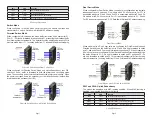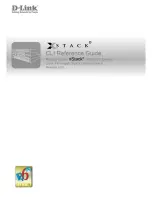
Page 9
When configured for Uplink Redundant Mode “no return to primary”, the uplink
ports operate as redundant links. A fault on the primary Port F1, will cause a fail
over to the secondary Port F2 within 50msec. Port F1 will become the secondary
port once the failure condition has been restored because “no return to primary”
has been selected.
Redundant Uplink
When configured for Uplink Redundant Mode “return to primary’, a fault on the
primary Port F1, will cause a fail over to the secondary Port F2 within 50msec.
The module will return to the primary Port F1 after the failure condition has been
restored for 6 seconds.
SW5: MAC Learning - “MAC Learning/Off”
When this DIP-switch is in the LEFT “MAC Learning” position (factory default), all
ports on the module will learn the source MAC address of each received packet and
store the address so packets destined for the stored addresses can be forwarded
to the appropriate port on the module. When the DIP-switch is in the RIGHT “Off”
position, learning is turned off and all received unicast packets are forwarded to
all ports.
SW6: Pause - “Pause Off/On”
Setting the DIP-switch to the LEFT “Pause Off” position (factory default) configures
the module to advertise no Pause capability on all ports. Setting this DIP-switch
to the RIGHT “On” position configures the module to advertise Symmetrical and
Asymmetrical Pause capability to all ports.
SW7: L2CP - “L2CP Tunnel/Discard”
When this DIP-switch is in the LEFT “L2CP Tunnel” position (factory default), all
L2CP frames will be tunneled through the module. When this DIP-switch is in the
RIGHT “Discard” position, all L2CP frames will be discarded.
SW8: Reserved
2) Installing the Module
The module can be wall or rack mounted using the optional Wall Mount Plate
(8260-3) or DIN-Rail mounted.
Page 10
Wall Mounting
Refer to the Wall Mount Plate user manual (040-08260-301x) for the proper
installation guidelines.
The wall mounting height of the module should be less than or equal to 2 meters
(6.6 feet) from the floor. Use the four mounting holes on the module to secure the
module to the wall. The module can accommodate #6 screws (not included).
Installation of the module should be such that the air flow in the front, back, side
and top vents of the switch are not compromised or restricted.
The accessory cables should have their own strain relief and do not pull down on
the module.
Rack Mounting
The module can be rack mounted using the optional Rack Mount Shelf (8260-0).
Refer to the Rack Mount Shelf user manual (040-08260-001x) for the proper
installation guidelines.
Follow the same guidelines above when rack mounting the module.
DIN-Rail Mounting
The module can be DIN-Rail mounted using the attached DIN-Rail mounting bracket.
3) Apply DC Power
This module is intended for installation in restricted access areas. (“Les matériels
sont destinés à être installés dans des EMPLACEMENTS À ACCÈS RESTREINT”).
A restricted access area can be accessed only through the use of a special key, or
other means of security.
The over current protection for connection with centralized DC shall be provided in
the building installation, and shall be a UL listed circuit breaker rated 20 Amps, and
installed per the National Electrical Code, ANSI/NFPA-70.
The 6 Port 10G/Mi re12 to +57VDC inclusive of tolerance (0.86A @ 12VDC
max rated power). The 10 Port 10G/Mi requires +12 to +57VDC inclusive of
tolerance (0.94A @ 12VDC max rated power). See specification table for specific
model requirements.
Appropriate overloading protection should be provided on the DC power source
outlets utilized.
Top View - Location of DC Power and DIP-switches
WARNING:
Only a DC power source that complies with
safety extra low voltage (SELV) requirements can be
connected to the DC-input power supply.


























